Designing a custom C-N bond formation screening using the multi-light screener in the Lucent360™
Description
With the Lucent360™ you can screen up to 4 four wavelengths independently in one experiment, while also controlling for temperature and light intensity. In this note, we demonstrate how this capability allows you to design a custom chemical screen with the flexibility to match the optimal wavelength for each catalyst and reaction condition. 
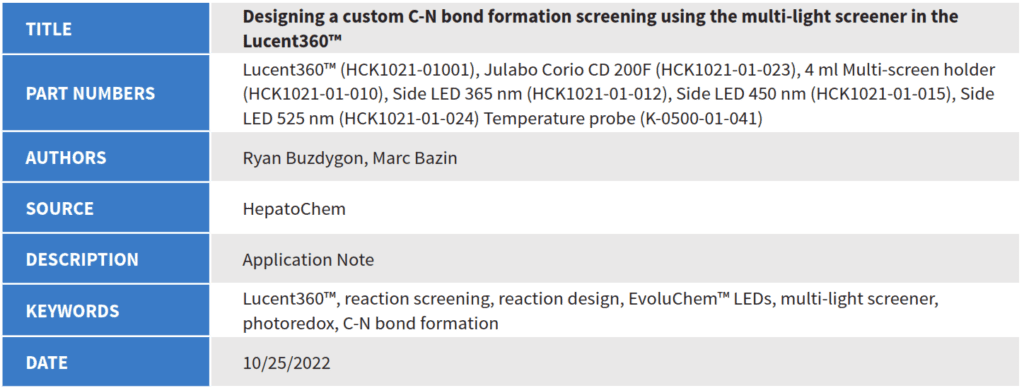
Instrument Configuration
The Lucent360™ includes four side LED modules and one bottom module. Each module is independently controlled and fully interchangeable allowing multiple configurations for wavelength and light intensity. For this example, we will operate the Lucent360™ with four different side modules to screen 365, 450 and 525 nm light. The light intensity for each side module is independently set at 50% and the bottom LED is not in operation for this experiment. Using the multi-light screening holder allows each quadrant to be operated independently without any interaction with the light from the other quadrants. For the 4 ml vial screener (HCK1021-01-010), up to 4 reactions can be performed in each quadrant (16 total). This function allows us to design a chemical screen with four unique catalysts each matched to an optimal wavelength for a corresponding C-N bond formation reaction.

The Lucent360™ temperature control unit maintains a constant and controlled temperature at all positions in the array. For this example, we will run all of the reactions at 25°C. This prevents temperature increases due to irradiation of the LED’s or from internal exothermic processes. The device can be operated from 0-80 °C with the appropriate coolant. Instrument Configuration
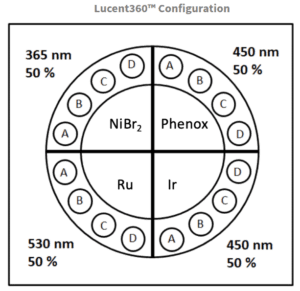
Reaction Screen Design
We set out to design a C-N bond formation screen based on known literature examples matched to the ideal LED wavelength excitation for each photocatalyst. The selected transformation occurs between an aryl bromide and secondary amine in the presence of a nickel source, base and a photocatalyst. Each of the four selected conditions uses a nickel catalyst without the need for an additional ligand. 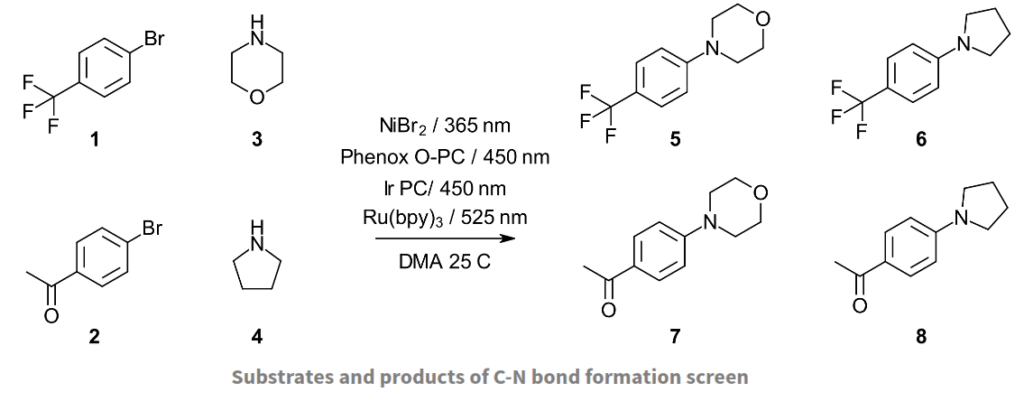
Substrate concentration, scale and catalyst loading were modified from the reported examples to standardize the four selected conditions. Using DMA as the solvent standardizes sample prep for the 4 substrate solutions. For this screen we selected 2 aryl bromides 4- bromobenzotrifluoride 1 and 4-bromoacetophenone 2 and 2 amines morpholine 3 and pyrrolidine 4 for the potential formation of 4 unique coupling products. The Lucent360™ configuration his affords the opportunity to test each of these potential combinations with each catalyst/wavelength. The first reaction is a NiBr2‚-catalyzed reaction using 365 nm LEDs that does not require a photocatalyst as reported by Miyake (Ref 1). The proposed mechanism invokes a Ni-amine solvent complex that is excited by the 365 nm light. This reaction proceeds without the requirement for any additional base if the amine selected is used with 3.5 equiv. of secondary amine.
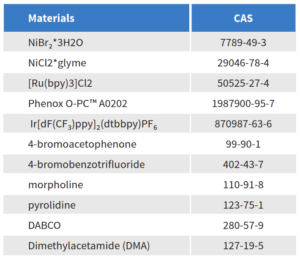
Experimental Protocol
In general, each reaction contains 0.8 mmol bromo (1 equiv.), 2.8 mmol amine (3.5 equiv.) , 2 mol % PC, 5 mol % Ni catalyst and if applicable 1.8 equiv. DABCO in 2 ml DMA.
- Reaction A: bromo 1 + amine 3 / product 5
- Reaction B: bromo 1 + amine 4 / product 6
- Reaction C: bromo 2 + amine 3 / product 7
- Reaction D: bromo 2 + amine 4 / product 8
The second reaction uses an organic photocatalyst Phenox O-PC™ A0202 (Ref 2) with 450 nm LED and NiBrâ‚‚. The development of organic photocatalysts as alternatives to traditional Ir and Ru photocatalysts represents an important advance in the long term viability of photocatalysis from both a cost and sustainability perspective. 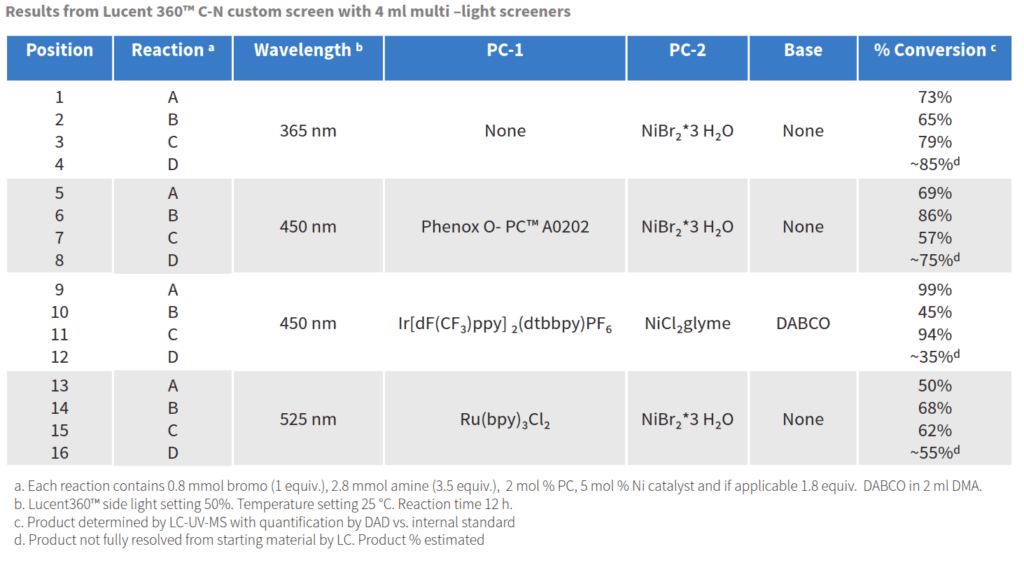 The third example as reported by Macmillan (Ref 3) utilizes perhaps the most commonly used iridium photocatalyst Ir[dF(CF₃)ppy]â‚‚(dtbbpy)PF₆ at 450 nm, NiClâ‚‚-glyme and 1.8 equiv. of an additional base DABCO. Use of the additional base allows a lower loading (1.5 equiv. of amine) for the reaction to proceed. The fourth reaction utilizes Ru(bpy)3, with NiBr2‚ at 525 nm as reported by Miyake (Ref 2). The authors found that with Ru(bpy)3 as the catalyst, the optimal C-N bond formation reaction occurred at 525 nm. There are many considerations for why flexibility of catalysts selection and reaction parameters can be important when planning out a reaction screen. Some factors can include the cost of the catalysts, stability in presence of substrates and suitable substrate scope. The flexibility of the Lucent allows for screening optimal conditions in 1 step for whatever type of chemical screen that you can imagine.
The third example as reported by Macmillan (Ref 3) utilizes perhaps the most commonly used iridium photocatalyst Ir[dF(CF₃)ppy]â‚‚(dtbbpy)PF₆ at 450 nm, NiClâ‚‚-glyme and 1.8 equiv. of an additional base DABCO. Use of the additional base allows a lower loading (1.5 equiv. of amine) for the reaction to proceed. The fourth reaction utilizes Ru(bpy)3, with NiBr2‚ at 525 nm as reported by Miyake (Ref 2). The authors found that with Ru(bpy)3 as the catalyst, the optimal C-N bond formation reaction occurred at 525 nm. There are many considerations for why flexibility of catalysts selection and reaction parameters can be important when planning out a reaction screen. Some factors can include the cost of the catalysts, stability in presence of substrates and suitable substrate scope. The flexibility of the Lucent allows for screening optimal conditions in 1 step for whatever type of chemical screen that you can imagine.
References
(1) Lim, C. H.; Kudisch, M.; Liu, B.; Miyake, G. M. C-N CrossCoupling via Photoexcitation of Nickel-Amine Complexes. J.Am. Chem. Soc. 2018, 7667-7673. https://doi.org/10.1021/jacs.8b03744. (2) Kudisch, M.; Lim, C. H.; Thordarson, P.; Miyake, G. M. Energy Transfer to Ni-Amine Complexes in Dual Catalytic, Light-Driven C-N Cross-Coupling Reactions. J. Am. Chem. Soc. 2019, 141 (49), 19479–19486. https:// doi.org/10.1021/jacs.9b11049. (3) Corcoran, E. B.; Pirnot, M. T.; Lin, S.; Dreher, S. D.; Dirocco, D. A.; Davies, I. W.; Buchwald, S. L.; Macmillan, D. W. C. Aryl Amination Using Ligand-Free Ni(II) Salts and Photoredox Catalysis. Science (80). 2016, 353 (6296), 279–283. Phenox-O-PC™ A0202 is a registered trademark of New Iridium

